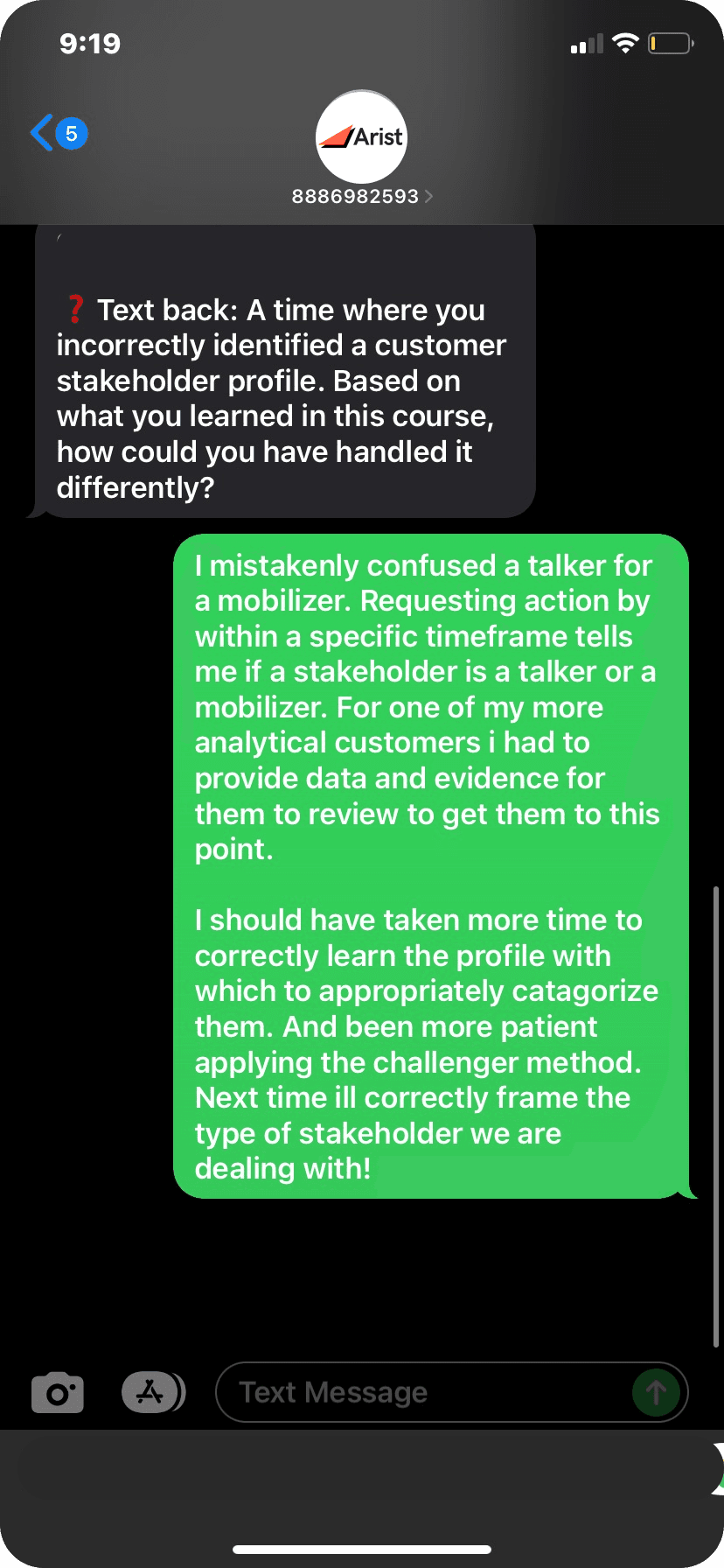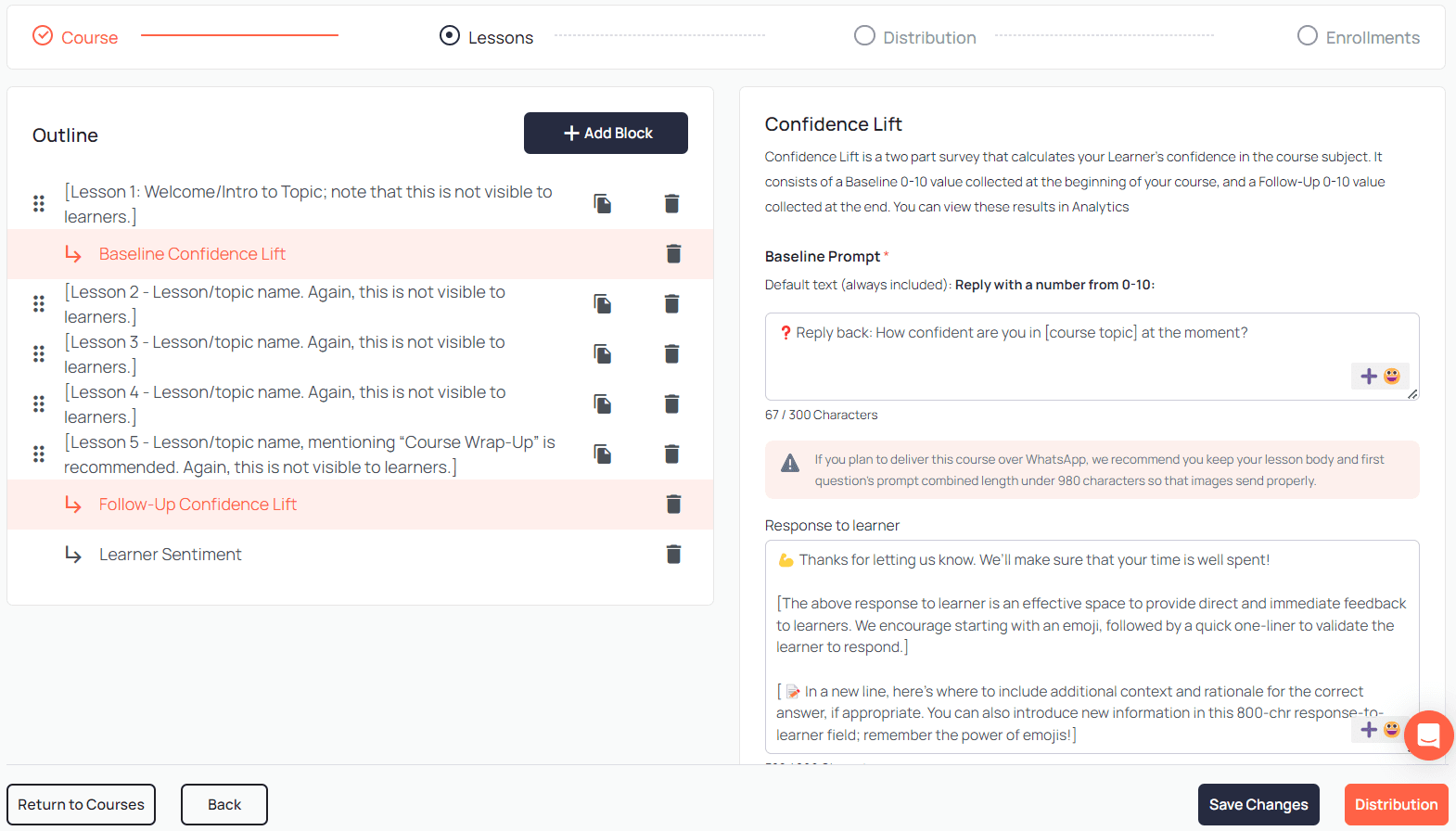Nudge theory for corporate change management, learning, and development
What’s one action that can make you 1% better at work this week?
It’s probably something simple you could practice right now.
1% better on a weekly scale isn’t that much. But over the course of the year it’s over 50% in productivity gains.
You’ve seen the inspirational posts on social media.
Insert nudges, low-lift moments overwhelmingly shown by science to change behavior in small increments.
You likely “get” the power of nudges. And you’ve undoubtedly experienced unobtrusive reminders of best practices yourself.
The opportunity: an L&D or HR team that can help a workforce get 50% better at their job has a literal superpower.
The issue: you need to be able to reliably nudge at scale.
As the only learning platform to deliver learning, nudges, and comms natively in messaging apps used by 91% of the planet, Arist has been in a good position to study what works and doesn’t in regards to nudges. And that’s what we’re going to present here.
Skip to:
What is nudge theory?
Nudge theory is a concept popularized in the 2008 book Nudge: Improving Decisions About Health, Wealth, and Happiness. This heavily-researched book is based on Nobel Prize winning work on how humans actually make decisions (hint, more often than not we proceed by instinct; nudges tap into instinct to support change).
So what is a nudge?
A nudge is a component within a behavior change program that does not forbid options, is cheap to forego and implement and that reliably changes behavior.
A nudge works to bridge the intention-action gap (see the Arist whitepaper), and relies on individuals intending to improve some area of their life to help them act out a small step in the right direction.
Examples of nudges include putting fruit or healthy snacks at eye level, or short reminder texts about secure passwords.
Accordingly, nudge theory is the study and best practices surrounding the use of nudges.
What are the benefits of nudge theory for change management, learning, and development
The main benefits to nudges are that they’re quick and affordable to implement (for change participants and change management teams), they also work. A peer-reviewed analysis of over 100 studies noted that nudges lead to statistically significant behavior change 62% of the time. And that the median percentage that behavior changes is 21%.
For scale, an adoption rate of 62% on an optional training would be considered top-notch. And nudges tend to be quicker and easier to build, test, and iterate on than entire trainings.
A high-level view of key nudging benefits include
They enable more continuous change management and improvement programs.
Thoughtfully implemented nudges can rely on more learner touch points to return more data.
Their spaced out and repetitious nature is more scientifically backed for retention of new information and habits.
The bite-sized nature of nudges is more aligned with how much time learners have than longform learning content.
Best practices for utilizing nudge theory
Nudge theory was birthed in the field of behavioral economics. Economics affects all of us. Accordingly, nudges have been tested and studied on wide representative swaths of the general population.
We aren’t saying you can’t put your own “spin” on nudges. Rather that you don’t have to as there are widespread and well-studied best practices.
Nudges rely on the way we naturally make decisions to get to a favorable outcome. As any Psych 101 class can attest to, we don’t tend to make very rational choices. So the first best practice of nudges it that they shouldn’t appeal to logic, they should appeal to basic human emotion.
One of the most widely known nudge campaigns is the inclusion of graphic warning labels on cigarette packs. For years cigarettes had fine print text noting the risk of smoking. While both of these warnings portray the same information, one is much more visceral and taps into our reactive brain. Study after study have noted the effectiveness of such labels. A simple change in messaging has been found to reduce the likelihood that moderately addicted smokers will buy cigarettes by close to 30%.
What does this look like in a corporate context? Obviously, graphic imagery is like in the case of cigarettes is likely a no-go. But there’s still plenty of emotion that can be harnessed for betterment in work.
Taking a deep dive into who your learners are, what their motivations, what their challenges are, and what their day looks like goes a long way towards being able to appeal to your learner base in this way. At Arist, we step many new clients through crafting learner personas to utilize these sorts of data.
Many organizations should already have some notion of what emotions might be most impactful in their case. Your organization — or teams within your organization — may be cause driven, or ambitious, data-driven, collaborative, or competitive. Each of these can be used to craft effective nudges.—
Secondly, nudges work better when they’re low-stakes, approachable, and present an option of no action. You may think authoritative language and mandatory measures would ensure likelier behavior change. But as we’ve all seen first hand, simply making someone watch a video or participate is not a great recipe for ensuring reliably better performance. Nudges are meant to work with an individuals innate desire to improve something.
In corporate contexts, this often looks like learning resources and prompts that arrive at an appropriate time and in an appropriate container. Learning delivered in an LMS is an average of 7 clicks and a search away. That’s not approachable enough. In-person learning that requires learners to “speak up” in front of a group isn’t low stakes enough.
Nudges are much more closely related to what we often call informal learning. But ideally informal learning that can be measured.
❓Reply back: What’s 1 specific way you can apply something from this course into your job?👍 Appreciate you sharing this insight! Continue thinking about aspects from these lessons you resonate most with, and what it would look like for you in action.
Above is the verbiage we often recommend using in Arist nudges sent via messaging apps. A moment of application and a message back is low stakes, approachable, and framed in a way where the learner could choose not to participate. But in many cases it’s also sort of a fun. Which supports our first best practice above as well.
Finally, nudges reference peer activity and social norms. Note that we aren’t recommending comparing peers in a judgmental way. Rather, when given a low-stakes and approachable action that has social benefits, learners are likelier to comply.
So what does this look like in practice?
We’ve seen learning teams effectively deliver nudges around the same subject matter but catered to different positions. For example:
Nudge trigger: performance review season is approaching
Sent to managers: anti-bias training with a nudge about providing feedback to IC’s
Sent to IC’s: training on effectively measuring and reporting progress with a nudge about communicating to managers
By taking in context about peer activity and providing scaffolding about social norms, it’s a “win-win” for all parties through better abilities to handle a mandatory performance review.
What nudges look like in the Arist platform
Arist’s messaging-app delivery of learning and comms is uniquely well positioned to take advantage of the best practices of nudge theory. Collectively we have deeply entrenched habits of quickly checking and responding to messaging apps. Messages are also perceived as commonplace and “easy” as well as highly accessible.
Nudges don’t have to take place digitally, or look like messages at all. It just happens that the digital equivalent of putting healthy foods “at eye level” is to put information you want consumed where we naturally look (messaging apps for most of us).
Together, these facts lead to over 90% of Arist learning moments being opened within 3m.
The learner experience

Within a messaging thread in SMS, MS Teams, Slack, and WhatsApp, conversational learning begins to unfold. Inherently, there’s a cap to how long messages can be. So learning moments are short. They’re also build around a back-and-forth asking learners to take actions and then report back on how they went.
At the end of a course, learners can be enrolled in follow up courses, or given a choice between topics of interest.
Additionally, spaced messages can be delivered at set intervals after course completion, either to nudge the learner to continue applying learnings, or to check back in on prolonged retention.
The admin experience

Settings controlled by admins help to mold how the learner interacts with nudges and learning moments. A variety of content “block types” provide differing behaviors ranging from polling to multiple choice, to before and after checks about confidence lift or the number of times an action is applied.
Admins can also control whether content is pushed to learners or they pull learning. For example, some teams make use of QR code signup placed in physical locations where a nudge to learn more is opportune.
While the bite-sized nature of messaging learning appeals to learners by being low-stakes and fitting into their day, it appeals to admins due to how quickly it can be created. Learning teams save an average of 82% on messaging course creation (check out our ROI calculator to see your potential time savings).
Together the range of block types for data capture and ease with which new learning can be deployed enable smarter iterations on learning, keeping it contextual and relevant.
The metrics admins can attach to nudging moments include:
Learner confidence lift - a percentage change in self reported learner confidence in a skill at the start and end of a learning experience
Completion rate - the percentage of a course a learner has worked through
Interactivity rate - the percentage of learning moment nudges a learner responds to
Learner NPS - a measure of how enjoyable and resonant the learning experience is on a scale of 0-10
Learner qualitative responses - useful for needs assessment and other forms of knowledge checks or polling
Additionally, to build behaviors we recommend focusing on the frequency and quality of application of new skills.
Frequency of application - is measured by the number of times learners report they were able to apply learnings from a nudge or course
Quality of application - a qualitative measure about the quality of the experience.
Quality of application can rely on multiple choice or free response blocks within messaging apps and can be graded on the following which relate greatly to gauging if nudges were a success:
Related: want to explore the admin experience? Try our interactive walkthroughs.
Examples of Arist nudges at scale
Messaging apps are arguably the most accessible technologies on the planet. By meeting learning populations where they already spend their time, Arist has helped to support numerous effective uses of nudges at scale.

The State of California needed a way to nudge residents to make safety plans in the event of wildfires. There was no feasible way to use traditional training to the 100,000+ individuals that needed behavior change. So they decided to utilize widely accessible delivery methods and bite-sized nudges to meet citizens where they already were .
Using SMS-based nudges, the State of California was able to ensure increase in self-reported preparedness for disasters for 93,000 Californians. In minutes a day over the 5-day nudge-filled course, $100’s of millions in potential damages were mitigated.

The Georgia Leadership Institute for School Improvement needed a way to incite difficult conversations and reflections on DEI topics to their educators statewide. With 5,000 extremely busy educators — often away from their desk — they knew they only had moments to educate and incite changed behaviors.
In the words of a learning designer who helped to implement the project, "the advantage for me as a learning designer was the constraint, because each day I felt like I said the most important thing. Crafting something like this from the ground up gave us a new energy, and I think that was because of the delivery mechanism. It felt brand new."
GLISI leaned into the concept of actionable self-reflection through nudges and prompts to apply. These interactions promoted the practice of being aware of oneself in an objective way from which one can make changes to future behavior.
Unsurprisingly, the repeated frictionless delivery along with focus on self reflection led to more impactful realizations, goal setting, and simply a more meaningful time in the course. GLISI saw 5x the adoption compared to longer form learning content, and was able to reach thousands of educators. Add to this that this was a voluntary training, and their completion rates of 50% were the highest they’d seen.
In the words of learners in response to nudges to reflect:
Merrill Cook
Bring
real impact
to your people
We care about solving meaningful problems and being thought partners first and foremost. Arist is used and loved by the Fortune 500 — and we'd love to support your goals.
Curious to get a demo or free trial? We'd love to chat:


